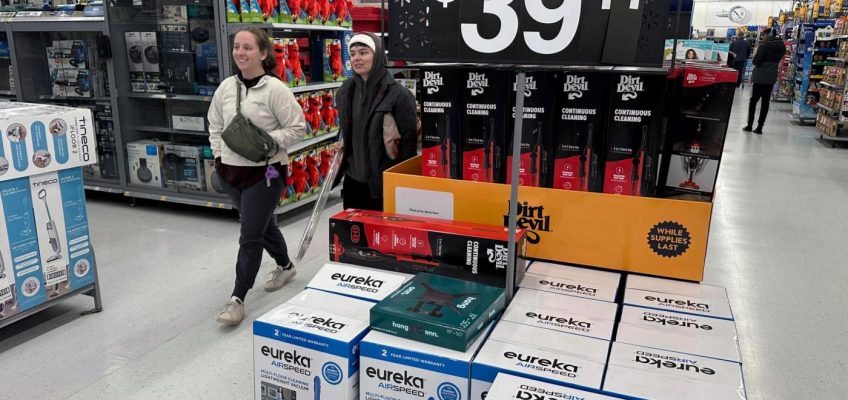By NICOLE WINFIELD, Associated Press
ROME (AP) — The pope looms so large in everyday Italian life that there are lots of expressions that make light of even a dark event like his death.
“A pope dies, they make another,” goes one, suggesting how life goes on.
“Every death of a pope …” starts another, indicating a rare occurrence.
But the one most frequently heard when a pope is actually sick is perhaps the darkest: “The pope is fine until he’s dead.”
FILE– The tapestries showing late Pope John Paul II, left, and Pope John XXIII hang from the facade of St. Peter’s Basilica as faithful and pilgrims crowd St. Peter’s Square at the Vatican, Friday, April 25, 2014. (AP Photo/Gregorio Borgia)
That one’s been making the rounds as Pope Francis nears a week in Rome’s Gemelli hospital, battling pneumonia and a complex respiratory infection.
While the Vatican has been providing twice-daily updates on his condition and Italian Premier Giorgia Meloni said they “joked around as usual” during her visit Wednesday, all kinds of reports — true and not — abound about Francis’ health.
They’ve taken on a life of their own in an age of chat groups, conspiracy theories and internet memes — not to mention the perennial Roman fixation on the pope and who might succeed him.
The ‘Conclave’ effect
It doesn’t help that the Oscar-nominated movie “Conclave” is in theaters and has made everyone an expert in the arcane rules and spectacular drama involved in a papal election. Or that Francis recently extended the term of the dean of the College of Cardinals rather than find someone new to fill a key job during the next papal transition. Or that at 88, he is one of the oldest popes ever.
FILE– Cardinals attend vespers with Pope Francis at St. Peter and Paul’s Basilica in Rome, Wednesday, Jan. 25, 2017. (AP Photo/Gregorio Borgia)
Francis still has a ways to go to outlive Pope Leo XIII, who died in 1903 at 93. But he’s on track to equal or surpass Pope Gregory XII, perhaps best known for being the most recent pope to resign until Pope Benedict XVI did so in 2013. Gregory was 88 when he stepped down in 1415 to end the Western Schism, according to online resource Catholic Hierarchy.
Francis has frequently said he, too, would consider resigning if his health made him unable to continue, though more recently he said a pope’s job is for life.
Vatican correspondents are usually preparing for upcoming papal trips at this time of year, but none are confirmed so far. Instead, between medical updates, they are preparing stories looking back at his life, just in case.
“I think the dictum of ‘A pope is fine until he’s dead’ is always true,” said Giovanni Maria Vian, former editor of the Vatican newspaper L’Osservatore Romano, who knows about how Vatican information is managed. “It’s a very Roman way of speaking that represents, on the one hand, the traditional skepticism of Romans and Italians, but on the other hand, an informational opacity.”
The Vatican hasn’t allowed any member of Francis’ medical team to appear on camera or give detailed updates on his health, and no photos of him have been released since his Feb. 14 hospitalization.
A papal video fuels rumors
But to understand how entwined the pope is in Italian life, one only needs to consider another tradition religiously observed by Italians: the annual Sanremo song festival, a weeklong series of shows on RAI television in which viewers vote for their favorite rising vocalists who perform nightly in the kitschy, sometimes bawdy contest.
When it opened last week, it made even more headlines than usual because Francis — already sick with bronchitis but not yet in the hospital — appeared on the show in a pre-taped video, a publicity coup for Sanremo and a papal first.
When popular Italian blog Dagospia subsequently claimed the video had been made nearly a year earlier for another event, near-hysteria broke out among Vatican watchers. The apparent deception suggested that Francis’ latest illness was much worse than it seemed, and raised questions about the solidity of the papacy if an old video had been released without the pope’s knowledge.
As it turns out, Dagospia was wrong. The video was legit, recent and recorded for Sanremo. But it was true that Francis’ bronchitis was indeed much worse than it seemed. By week’s end, he was hospitalized with a lung infection that turned into pneumonia.
The episode though underscored the truism that the papacy is a matter of general public knowledge, interest and debate here, and that speculating about the pope’s current health and who might be next is a national pastime.
“I’m certainly very, very worried,” said Maurizio Di Folco, who was being treated Tuesday at the same hospital. “I wish him a speedy recovery and we’re praying for him deeply. A very good pope. A great pope! We hope he’ll be with us for a long time to come.”
Francis’ conservative critics weigh in
But elsewhere, Francis’ right-wing critics are circulating alarmist -– and wholly uncorroborated -– stories about his condition. Archbishop Carlo Maria Vigano, a Francis nemesis who was excommunicated for schism last year, revived his conspiracy about the legitimacy of Francis’ 2013 election, calling for the CIA to investigate what he claims was a “Deep State” plot to elect him.
Francis knows this dynamic well.
“Some wanted me dead,” he told Slovakian Jesuit priests in 2021, referring to what he learned while he was hospitalized that year for intestinal surgery. “I know there were even meetings among priests who thought the pope was in worse shape than what was being said. They were preparing the conclave.”
It’s considered poor taste to discuss publicly who’s up or down in the papal stakes of a future conclave, much less to start plotting one. But privately, Rome is abuzz with such conversations. Taxi drivers chat about it with passengers, doctors with patients, butchers with customers.
For now, Francis is holding on. Thursday’s bulletins said he had breakfast sitting up in an armchair and was working with aides after blood tests showed a “slight improvement” in his inflammation.
“There is a greater measure of transparency, but even that is not complete,” said Christopher Bellitto, a church history professor at Kean University in New Jersey. “Surely everyone with aging parents and grandparents said, ‘that’s pneumonia’ before the Vatican did.”
Visual journalist Silvia Stellacci contributed.
Associated Press religion coverage receives support through AP’s collaboration with The Conversation US, with funding from Lilly Endowment Inc. The AP is solely responsible for this content.




